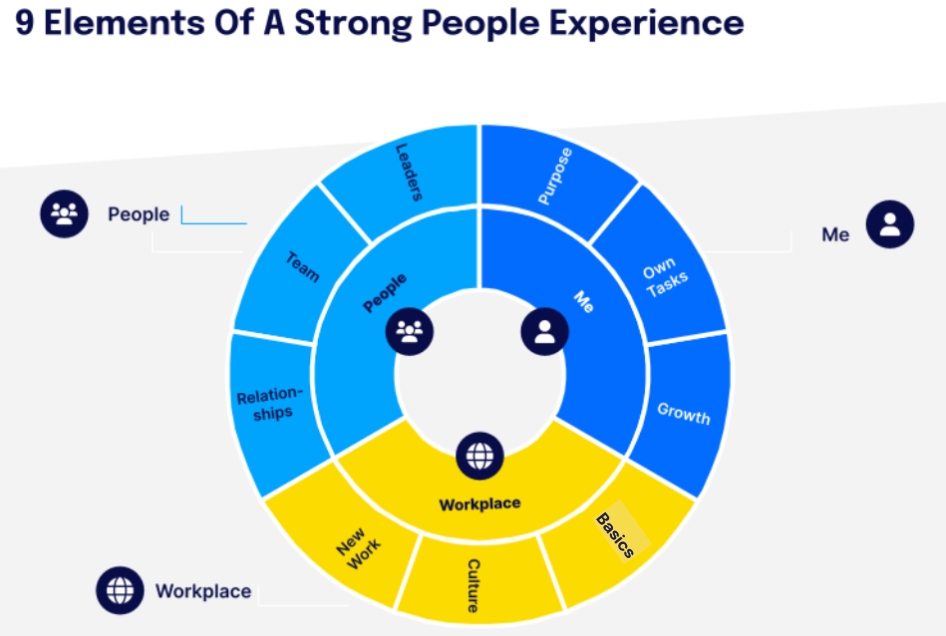Although we’ve known it all along, here it is in black and white: Inadequate communication is the main reason why change processes fail. It bears repeating though, because successfully shaping change and getting everyone on board is more business-critical than ever before. Internal communication plays a crucial role in this process. Only when the reasons, objectives, and context of any proposed changes are transparent from the get-go can you convince everyone involved to help make them a reality. So, if this is something we’ve always known, you’re probably wondering what it has to do with new internal communication trends.
It’s this: The demands of transformation processes are constantly evolving. Likewise, internal communication must continually evolve in order to keep up. That’s why this year’s trends all involve new ways for IC to communicate if it hopes to make change processes a success.
New year, new trends in internal communication
In internal communications, the turn of the year is a great time to consider new strategic topics and trends, but it’s also a time to reflect on the previous 12 months.
Let’s take a look back at our trends from 2023:
- Internal Communications as a Key Partner in Change Management Processes
- Reducing Complexity: An Important Trend for Internal Communication in 2023
- Working With Analytics Is Gaining in Importance
- 2023 Will Be the Year of Better Relationship Management
- Working Across Departments: Internal and External Communication Continue to Grow Together
- VR Technology on the Rise: Will the Rise of 3D Content Begin in 2023?
- Mental Health and Digital Wellbeing Will Remain a Hot Topic in 2023
We can’t say that these trends are no longer relevant. However, we’re convinced that we will need to focus even more in 2024 in order to successfully manage our resources, our tasks, and ourselves. In particular, we’re no longer calling mental health a trend, but rather a must-have.
We’re seeing more and more corporate mental health initiatives and hearing the kinds of personal stories that are finally giving people the confidence to open up and share their struggles. Thanks to everyone who’s had the courage to share their individual experiences with us. Please don’t stop! 💛
Looking ahead to 2024, we’ve agreed on five trends that we believe point the way forward for the strategic direction of internal communication:
Let’s start with the first trend:
1. Creating trust and security in turbulent times through reliable communication
A few days ago I read an article about a new drug. Only later did I realize that the entire piece was fake. The pictures and quotes seemed real, but in fact there was nothing genuine about the story itself. I found this quite scary. I trust my ability to tell what’s true from what’s false. The fact that I was fooled — even just temporarily — proved to me just how difficult it is to identify trustworthy sources on the internet and social media. Despite our best efforts, we’re surrounded by so much news and information every day that our brains automatically start absorbing and processing it before we even have a chance to figure out whether it’s true or not.
As ICs, we need to counteract this phenomenon. Within our “corporate cosmos,” we’re lucky to work with a manageable number of communicators and face little pressure to artificially drive click rates or place product advertising. We can and should concentrate on doing solid research and reducing doubts or fears.
Our job isn’t so much about covering a mass of topics and keeping up with a news cycle where something new happens every day. On the contrary, our routine, honest, and human communication should provide security and put trust in both the information we share and in the company overall.
When it comes to the topics we cover, IC is allowed to say no and schedule breaks that give employees the space they need to absorb and process the content we share.
Especially in situations where news from the outside world can be threatening, IC can create a communication culture within the company that reassures employees by being a consistently reliable source of information.
Let’s bring some order and breathing room to slow the flood of information and strengthen trust in ourselves as content creators.
Which brings us directly to the second trend!
2. Know the difference between storytelling and narrative
To understand this trend, let’s briefly explain the main difference between storytelling and narrative:
Storytelling is the means, narrative is the end.”
This means that the narrative forms the “framing” of stories. Usually, stories are framed by my own concerns — in other words: “What does the story mean for ME and how does it influence MY actions?”
Let’s use the latest Barbie movie as an example:
The stories we’ve heard:
The New York Times calls it “A savvy, updated riff on the Greek myth of Pygmalion”
Your friends can’t stop talking about it.
You’ve heard that it’s the first movie by a female director to gross $1 billion.
Your favorite podcast says it’s so much fun.
The narrative forming in our heads:
I think I need to see this Barbie movie!

With narratives, the focus is more on influencing your target group than just sending unrelated messages and stories. As communicators in the company, we therefore have the opportunity to use our storytelling strategically (in collaboration with managers and top management) to create narratives that significantly influence the actions of our employees.
Take for example how many companies are attempting to lessen their carbon footprint — or any other major change project. As we all know, simply getting people to accept the need for change is a big challenge. Such initiatives will definitely have a better chance of success when employees can develop a positive or motivating narrative surrounding them.
This is where the third trend comes into play:
3. No more change management without communication managers
Let’s be honest: we’re all tired of hearing the word “change.” At the same time, there’s almost no company that isn’t experiencing change on some level. We’re not going to delve too deeply into change management itself, because the most important rules haven’t changed:
- Change can’t happen without leadership!
- Top management serves as a role model and must drive change forward positively.
- Key messages should be repeated 16 to 21 times in order to anchor them in everyone’s minds.
- Information alone does not change behavior. Change must also be communicated and understood on an emotional level.
And last but not least, our perennial favorite: Change management requires strong communication!
Since we’ve been talking about change management for years, let’s limit our trend to a clear focus:
Don’t start any more change projects without the involvement of corporate communications. It simply won’t work. What’s more, it’s time to stop internal communication from being forced into the role of savior when it’s discovered too late that transformation processes aren’t going as well as expected. Stop waiting until it’s too late and get IC involved from the start!
4. People experience (PX) becomes even more important to IC (and the overall strategy)
Let’s get this out of the way first: People Experience is not a rebranding of HR. Regardless of whether it’s the HR department, labor management, HR management, or even the PX department. People Experience stands for a strategic attitude in companies and should always be part of the overall philosophy and strategy. PX describes a holistic approach to influencing how people feel about working in their company. For this reason, internal communication (alongside many other functions such as leadership, IT, training, healthcare, etc.) plays a crucial and central role.
To better understand this, we have developed nine elements for a strong PX:

For 2024, make a note of these elements and define and support them both in HR and internal communications. The nine fields all describe large, diverse areas in whose design HR and corporate comms can (and should!) have a major influence.
The tasks of internal communications lie primarily in the provision of various platforms and channels, the development of narratives, the structuring of important content and information, as well as the support of virtual and physical encounters, relationships, and exchange opportunities.
As communicators, we must use our expertise and knowledge to help shape the people experience in such a way that employees feel valued and taken seriously. Starting with top management, we have the opportunity to build and strengthen transparent, honest, respectful, and relevant corporate communication that significantly strengthens the well-being and sense of belonging of employees.
5. Use Artificial Intelligence correctly (and carefully) in IC
It seems like a dream come true: new systems that can generate convincing text in terms of content and language and save content creators countless hours of research, help find the right words, and write perfect headlines. That sounds fantastic, and let’s be honest, it is pretty amazing.
We firmly believe that AI and IC belong together and complement each other very well. Nevertheless, we would like to share a few thoughts with you so that AI can support your work — as opposed to replacing your role entirely.
Even if it may seem like it, AI didn’t suddenly appear from out of nowhere. It has been playing a major, albeit discreet, role in our digital lives for many years. To gain an even better understanding of the systems behind AI and the levels we’re dealing with, take a look at our detailed blog article “AI and Internal Communication: Harnessing the Potential for Business Success.”
Here’s an excerpt from the above-mentioned article, 4 guidelines for the correct handling of AI:
- Be a reliable source of information and establish communication channels that your employees can trust. Distinguishing between authentic and fake content, especially on social media, is becoming increasingly difficult. It is therefore important to take ownership of content creation, maintain control of the narrative, and check AI-generated content for accuracy.
- Get involved in the development of AI guidelines. In the early days of social media, companies had to create and communicate guidelines for its use. Now it’s important that communications teams make sure they are involved this time too when it comes to creating AI guidelines.
- Experiment with AI and use it as a source of inspiration to make your day-to-day work easier. When used correctly, AI can save you a lot of time for more important tasks. If you have writer’s block, it helps you to quickly fill empty pages, and AI supports your idea generation in creative processes. By using appropriate instructions (so-called prompts) in tools such as ChatGPT, AI can support your research or suggest alternative headings and conclusions.
- Develop expertise in the field of AI. Expand your knowledge of AI and become an AI champion who informs managers and employees about the benefits and possibilities of artificial intelligence. The basis for this is, first and foremost, to not be afraid of generative AI. By using AI to make smarter business decisions for your company, you will also strengthen your role as an expert in the further development of internal communication.
Have we forgotten something? Let us know in Comms-unity our English-speaking comms community. What do you see as trends for internal communication in 2024? We look forward to hearing about them.




